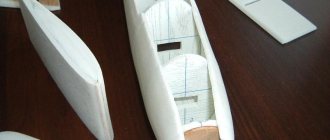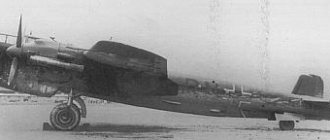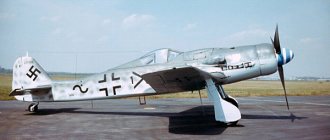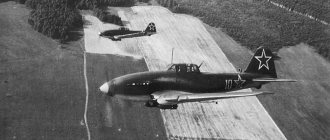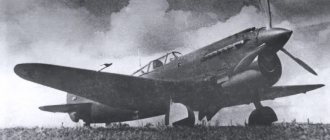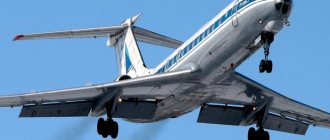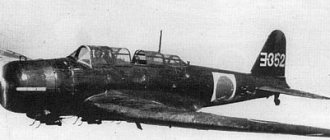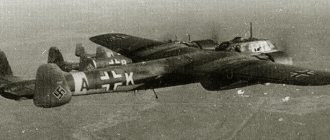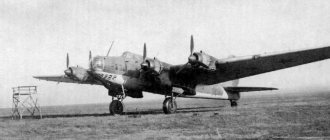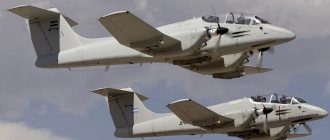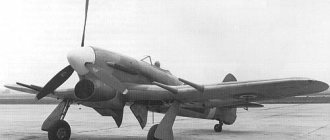Aircraft designer Hugo Junkers was a socialist and pacifist. This played a significant role in the fact that when the company was gripped by a crisis, they tried to remove him from it and nationalize the enterprise. The name was not changed, and to this day the name of the designer is associated with combat aircraft that formed the backbone of the bomber aviation of the Third Reich.
And if the first in popularity can be considered the famous “lapotnik” - the Ju.87 dive bomber, then next to it will be the medium high-speed bomber Ju.88. And not only a bomber - the “eighty-eighth” did not have to be anything other than a transport.
History of creation
In 1935, the Reich Air Ministry formulated a list of requirements for the design of a high-speed bomber capable of carrying up to a ton of bombs and reaching speeds sufficient to evade any fighter. Defensive weapons were initially not envisaged in principle, but a little later they decided to equip the aircraft with one normal-caliber machine gun.
prepared two projects - the Ju.85 with a two-fin fin and the single-fin Ju.88. In the spring of 1936, the Reich Ministry chose the “eighty-eighth” and signed a contract with the company for the construction of prototypes.
The first Ju.88V1 took flight only in winter. The plane did not meet the speed requirements - instead of 500 km/h, it reached only 449. On the second prototype, which took off in the spring of 1937, the aerodynamics were somewhat improved due to a different arrangement of oil coolers. The increase in speed, however, turned out to be small - the Ju.88V-2 reached 465 km/h.
On the third aircraft, instead of Daimler-Benz DB-600 engines, more powerful Jumo-211 engines were installed. Aerodynamics were further improved by installing oil coolers “in a package” with cooling radiators.
In the fall of 1937, the Ju.88V-3 not only met the speed requirements - it exceeded them, accelerating to 520 km/h. It was recommended that Junkers be put into production by preparing a pre-production batch.
However, in 1938, a serious change was made to the terms of reference. Now the high-speed bomber was also required to carry out dive bombing. The design of the aircraft had to be strengthened, air brakes installed, and an automatic dive developed. The speed, of course, decreased, and there was no longer any hope of being able to escape from any enemy. So we had to strengthen the defensive weapons to three machine guns.
However, the Reich Ministry was pleased and not only accepted the Junkers into service, but also began making plans to replace all medium bombers with it. Combat units began receiving “eighty-eighths” in 1940.
Preliminary tests
In November 1939, Professor Hertel, through the planning department of the design bureau, presented a gigantic test program for the Ju 288. This program involved almost the entire design department of the Junkers company, which was the largest among German aircraft manufacturing companies, in testing for months in advance. Professor Hertel knew that time advantage over competitors could be the deciding factor in winning a contract. The preliminary testing program, for example, included pressurized cabin testing, low-temperature testing of rubber products, lubricants, oils, flutter studies, wind tunnel testing and water towing. In total, the plan included 140 separate points.
At the time of the program's release, Junkers planned to fly the first prototype Ju 288 V1 in August 1940. Until this point, the company planned to test a number of new components in the air, for which several Ju 86 and Ju 88 aircraft were converted. For example, Ju 288 cockpit side blisters were installed in the rear fuselage of the Ju 86 V31; Later, the Ju 86 V31 prototype was used to test Hirth equipment and units. Then Ju 86 P/0294 was connected to the tests. On the Ju 86 P V28, a pressurized cabin was systematically tested with equipment designed for installation on the Ju 288.
in March 1940, a prototype Ju 288 V1 prototype was made, which corresponded to a later version of the requirements of the General Staff. In the background you can see an early version of the four-seat flight deck with the lower part protruding under the fuselage. The area where the model was assembled was strictly isolated by partitions from the rest of the workshop, and entry into this fenced-off area was allowed only to personnel who had the appropriate clearance
The Ju 88 V1 prototype was used to test the rapid fuel release system, test elevators and study visibility conditions during rain. A mock-up of the Ju 288 cockpit was installed on the Ju 88 V2 prototype and then the operation of the ailerons was tested using a jet spray and a comb chopper. The Ju 88 V5 prototype was fitted with a mock-up of the Ju 288 cockpit and a twin-fin tail unit. Tests were then carried out on the evaporative cooling system, the overpressure liquid cooling system, the twin propeller spinners and the airbrakes for dive flight. On the Ju 88 V8 and Ju 88 V16 prototypes, rudders were tested, on the Ju 88 V 17 prototype, the on-board equipment was tested, and on the Ju 88 V23 and V42 prototypes, elevator trimmers with the pin axis moved forward were tested.
Design
The Junkers was an all-metal, twin-engine, low-wing aircraft. Wing with working duralumin skin on duralumin spars. There were four fuel tanks in the wings. To combat icing, the wing tip was heated with hot air from the engines.
The duralumin fuselage was divided into three parts.
In the bow there was a cabin for four people, who made up the entire crew of the “eighty-eighth”. The pilot and navigator-bombardier (who also fired from the bow machine gun) sat in front, followed by the radio operator and flight engineer. The radio operator was also a shooter from the rear machine guns, and the flight mechanic fired from the lower one.
The middle part of the fuselage was occupied by two bomb bays, in which additional fuel tanks could be mounted. Only small-caliber bombs could be hung in the bomb bays; more powerful ones were used only from external hangers.
Most aircraft were equipped with 12-cylinder V-shaped Jumo engines, but ring-shaped cooling radiators gave the engine nacelles a look more typical of aircraft with radial engines.
Firing sectors
The upper rear firing point (two machine guns) has a satisfactory firing sector: +/- 75 degrees in azimuth and 35 degrees in elevation. The lower shooting point has 40-degree sectors of fire to the left and right of the “dead zone,” but it is easier to fire to the right than to the left, since the butt of the machine gun rests on the shooter’s right shoulder. The maximum descent angle of the machine gun is 30 degrees; firing at a target located behind the tail is impossible. The front machine gun has a very limited field of fire; it has to be fixed in a horizontal position, since the pilot fires from it, although controlling the aircraft does not allow the pilot to concentrate on firing the machine gun.
Modifications
The main production series was A - bombers with Jumo-211 engines. The Ju.88B, on which it was planned to install a new cockpit design, did not go into production. The developments obtained during the tests were used to create a new Ju.188 bomber.
The Ju.88C series aircraft were heavy fighters.
In the Luftwaffe, this class of combat aircraft was called Zerstorer - “destroyer”. Behind the formidable name they hid rather vague ideas about how such aircraft should be used. They tried to use the Destroyers both to fight for air supremacy and to escort bombers, but without much success.
During the “Battle of Britain”, the Ju.88 C series operated more or less effectively, attacking British fighters on takeoff or landing. Later modifications of this series were converted into night interceptors. The planes differed from bombers in their all-metal nose cone and forward-facing armament, which reached three 20 mm cannons.
The D series included long-range photo reconnaissance aircraft, built on the basis of the Ju.88 series A. Cameras were installed on them in the bomb bays. G series - advanced night fighters. They were equipped with BMW-801 engines, a tail unit from a Ju.188, and front-facing armament consisted of four 20 mm caliber guns. One of the main modifications was the Ju.88G-6 with Jumo-213 engines, on which Liechtenstein or Neptune radars were installed.
Based on the G series, the Ju.88H with an extended fuselage was released.
Unlike other production series that united single-purpose aircraft, the H series included both a long-range naval reconnaissance aircraft and a fighter designed to intercept convoy escort aircraft.
They tried to use the Ju.88 P series as an attack aircraft. In the ventral container, the aircraft carried either a twin installation of 37 mm caliber guns, or a single installation with a 50 mm or even 75 mm caliber gun. It was assumed that with such weapons he could easily destroy tanks or shoot at heavy bombers from a long range.
As for bombers, their production was not limited to series A. The S series was produced from the end of 1943. To improve aerodynamics, they had an improved transparent fairing; the nacelle for the lower gunner was abolished. Most variants flew with BMW-801 engines equipped with a nitrous oxide injection system. Finally, a small series of photo reconnaissance aircraft based on the Ju.88S received the designation “T”.
Functionality
One machine gun was fired on the ground, three aft machine guns were tested in the air in flights over the sea. There were no delays when firing; recoil when firing was small at all angles of rotation of the machine guns. The rate of fire is 1000 rounds per minute and produces very little smoke and flame when fired. Approximately every fifth cartridge in the magazine is a red tracer. The rest are armor-piercing, incendiary and explosive. Night shooting showed that tracers have virtually no effect on the shooter. Overall impression of the machine guns: very simple and extremely effective. The magazine replacement time is five seconds.
Application
Ju.88s were actively used from the beginning to the end of the Second World War, starting with the invasion of Poland. Although bomber production had not yet been fully developed, 12 were specially selected to be tested in combat. And by the time the invasion of France began, the “eighty-eighths” were already part of all combat units.
In France, it turned out that the Junkers, despite its high performance (it also turned out to be a good dive bomber), was difficult to master.
Inexperienced crews suffered heavy losses on it and preferred to fly the already aging He-111.
In the aerial “Battle of Britain”, the “eighty-eighths” suffered the heaviest losses of all Luftwaffe bombers. And by the time the Ju.88A-4 with more powerful engines and enhanced weapons went into production, the main battles had already ended.
By the beginning of Operation Barbarossa, the Ju.88s had already been sufficiently mastered by the crews, and had almost replaced the Do.17 aircraft. The first days of fighting on the Soviet front demonstrated the high effectiveness of the Junkers. However, when the bombers were intercepted by Soviet fighters, they suffered losses. The shortage of front-line Ju.87 dive bombers forced the use of “eighty-eighths” for direct support of troops. In such cases, they, not having sufficient armor, were often hit by fire from the surface.
Ju.88s continued to be produced and actively used until the end of the war, even despite the launch of the more advanced Ju.188 series.
In the second half of the war, outdated and worn-out bombers began to be converted for use as part of the Mistel system. The aircraft were converted into unmanned missiles controlled by radio from a fighter carrier.
24 Junkers were received by the Finnish Air Force. They were used against Soviet troops with some success. After the war, Finland was prohibited from operating bombers, and the aircraft were used for some time as trainers. Until 1951, captured Ju.88s were used by France.
Review
The visibility from the pilot's seat does not meet our standards. The pilot sits very high, his head almost touching the canopy. The pilot has a good view only forward and to the left. The view to the right is limited by the machine gun and the cockpit canopy. The pilot's seat is located behind the planes of rotation of the propellers, so the view over the engines on the Ju-88 is better than on the Blenheim. The canopy is made of flat panels, so the image is not distorted by the glazing. The top shooter has good all-round visibility, but only in the upper hemisphere; the bottom shooter is responsible for viewing the rear lower hemisphere. If the bombardier is not located in the forward fuselage, the lower forward hemisphere constitutes a "dead zone".
Technical data and comparison
In the USSR, the Pe-2 dive bomber was a direct analogue of the Ju.88. Developed as a heavy high-altitude fighter, the Pe-2 was converted into a dive bomber precisely after the visit of Soviet aircraft designers to Germany and their familiarization, in particular, with the Junkers.
To compare with the later series of the “eighty-eighth”, you can take another Soviet aircraft - the Tu-2.
| Ju.88 A-4 | Ju.88 S-1 | Pe-2 | Tu-2 | |
| Length, m. | 14,4 | 14,8 | 12,6 | 13,8 |
| Wingspan, m. | 20 | 20 | 17,3 | 18,8 |
| Maximum take-off weight, i.e. | 14 | 13,8 | 8,5 | 11,7 |
| Maximum speed, km/h | 467 | 605 | 540 | 528 |
| Practical range, km | 2170 | 2850 | 1200 | 2020 |
| Combat load, i.e. | 2,4 | 2 | 1 | 2 |
The Pe-2, inferior to the “eighty-eighth” in terms of range and weight of bomb armament, was significantly superior to most Junkers in speed. However, the real characteristics of the early “Pawns” could be worse than the tabular ones - this was due to the low quality of workmanship.
And the Tu-2, inferior to the later Ju.88 in terms of maximum speed, could carry up to three tons of bombs when overloaded. In addition, there were “long-range” modifications of the Tu-2, much ahead of the Junkers in terms of combat radius.
The Ju.88 was probably the best Luftwaffe bomber in its class. He demonstrated excellent performance in such varied missions as destroying tanks by dive-bombing and intercepting heavy bombers.
In the post-war period, however, it was almost never used for combat purposes and was replaced as soon as possible. Currently, only two of these aircraft remain intact.
Characteristics of Junkers Ju.88
A country:GermanyType:BomberYear of issue:1939Crew:4 peopleEngine:2x Jumo.211J, 1340 hp each.Maximum speed:467 km/hPractical ceiling:8200 metersRange of flight:1780 km (fertilization - 2730 km)Empty weight:9.86 tonsMaximum take-off weight:14 t (12.1 t - normal take-off)Wingspan:20.08 mLength:14.36 mHeight:5.07 mWing area:54.7 sq.m.Weapons:2x MG-131 machine guns, 3x MG-81 machine guns, up to 3 tons of bomb load
Changes in project management
Simultaneously with the invitation to participate in the competition, a decisive change occurred in the project management. Professor Herbert Wagner, who had been relatively unsuccessful at Junkers as head of the design department, left the company, as did the head of the design department, August W. Quick. Herbert Wagner went to Henschel, and August Kick to the German Aviation Research Institute (Deutsche Versuchsanstalt fur Luftfahrt; DVL). Junkers was able to obtain a new head of project management. He became Heinrich Hertel (1901-1982), who left the Heinkel company due to disagreements with its leader Ernst Heinkel. Hans Gropler (1909-1969) became the new head of the design bureau. Thus the Ju 288 program became Heinrich Hertel's first big test at Junker. Hertel responded to this challenge with his characteristic energy, and soon at Junkers he received the nickname “Heinrich the Lion” (Heinrich der Löwe).
It should be noted that the head of the company's design bureau, Ernst Zindel, did not take part in the entire development of the Ju 288. Under the leadership of Ernst Zindel, the Ju 86 medium bomber was created. Although this aircraft was put into mass production, its design was outdated in comparison with competitors He-111 and Do-17. The disappointment with the defeat of the Ju 86 by the head of the Junkers company, Koppenberg, was so strong that in the future Ernst Zindel no longer took part in the company's new developments. Therefore, designers Alfred Gassner and his friend Heinrich Evers were specially called from the USA to work on the Ju 88. At the same time, Alfred Gassner, while working at Fairchild, did not distinguish himself with particularly advanced projects.
Further tests
In addition to a large number of other tests that it is not possible to describe due to lack of space - for example, experiments on ensuring the protection of flaps from changes in speed pressure and the use of a comb breaker as an additional means of lateral control - the company's engineers tested the following on the Ju 288 V2 prototype called control path converter (Steuerungswegwandler).
In early prototypes, pilots found the longitudinal and yaw control systems to be more sensitive when the deflecting surfaces were in neutral. Minor deviations of the steering wheel or pedals made it difficult to fly smoothly in the direction of the target. To improve, a so-called control path converter was created and, with the same deflection of the control system elements in the middle position, the ratio of the movement of the pedals or steering wheel to the movement of the deflecting surfaces was increased to 2:1. This measure made it possible to obtain a significant improvement in aircraft control during a long flight, and it was decided to use this system in mass production.
When the Ju 288 V2 prototype landed at Dessau airfield on July 20, 1942, and skidded off the runway, the landing gear was broken. During the ensuing repairs, the B-type defense mount and the Junkers-developed FA 15 remote weapons control system were installed. The aircraft was delivered to the Tarnewitz test center in November. There is information that the Ju 288 V2 prototype remained at this test center until March 1943. After the return of the Junkers company, this aircraft was no longer flown, and in December 1943 it was scrapped.
On July 20, 1942, during rain, Holzbaur's prototype Ju 288 V2 rolled off the runway at the Dessau airfield, resulting in a broken landing gear. On the right wing console you can discern a pitot tube that served for continuous control of flap adjustment
a reference to Henry the Lion (German: Heinrich der Löwe, 1129, Ravensburg, Tübingen - August 6, 1195, Brunswick) - a monarch from the Welf dynasty, Duke of Saxony in 1142-1180 (under the name Henry III) and Bavaria in 1156-1180 ( under the name of Henry XII)
